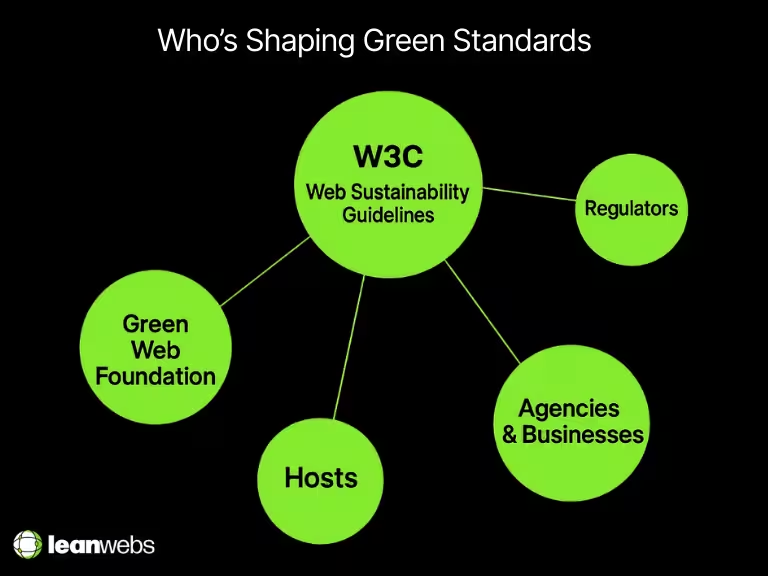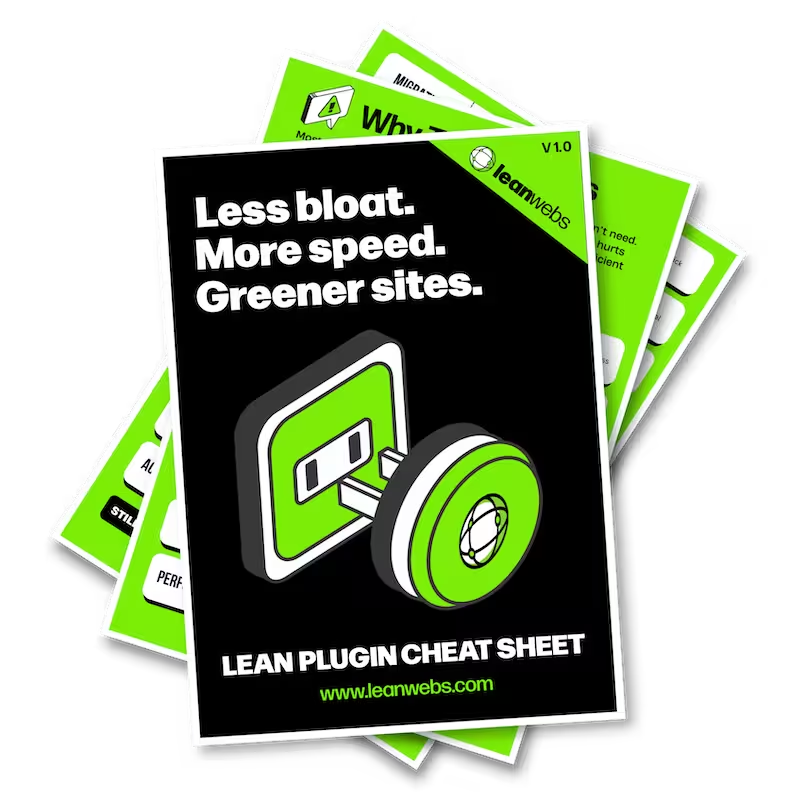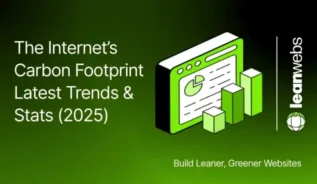The web is changing fast, and not just in how it looks or how quickly it loads. A quiet shift is underway that could redefine the rules of building online. For the first time, sustainability is moving into the same league as performance, accessibility, and security.
Table of Contents
Why now: Web standards must go green
For years, web standards have chased speed. Smaller scripts, faster loads, leaner code – all good things. But here’s the bit that’s been missing: the web has a carbon cost. Every oversized image, every autoplay video, every unused plugin draws power somewhere. At scale, those choices add up to more emissions than the entire aviation industry (The Internet’s Carbon Footprint in 2025).
That’s the wake-up call. The next wave of standards won’t just ask, “does your site load fast?” They’ll ask, “does it load clean?”
And that shift is bigger than it sounds. Think about accessibility: once a side note, now a baseline expectation. Sustainability is heading the same way. Whether you’re running a two-person online shop, shipping sites for clients, or tinkering with a side project, the rules of the game are changing.
The good news? You don’t have to wait for regulation to catch up. The first drafts are already here, and early adopters will be the ones shaping what “green by default” really means.
The foundation: W3C’s Web Sustainability Guidelines
If you want a clear signal of where green standards are heading, look at the Web Sustainability Guidelines (WSG). Drafted by the W3C’s community group, they’re not some abstract manifesto – they’re a practical checklist for a cleaner web. Ninety-four recommendations cover everything from design patterns to hosting choices, and together they frame sustainability as seriously as we’ve long treated performance.
What the guidelines cover
The WSG encourage us to zoom out. It’s not just about shaving milliseconds off load times, it’s about designing responsibly across the stack:
- UX: give users low-energy options and respect reduced-motion settings.
- Development: cut bloat, keep the DOM lean, and avoid redundant scripts.
- Hosting & delivery: prioritise renewable-powered providers and efficient CDNs.
- Strategy: plan content with carbon in mind and measure impact alongside engagement.
For a practical grounding, see What Is Sustainable Web Design and Why It Matters or learn how to calculate your website’s carbon impact.
Why adoption is slow
Here’s the reality: most teams haven’t even heard of the WSG yet. And without client demand or regulation, they slide down the priority list. As Tim Frick (Mightybytes, WSG co-chair) puts it, the stumbling blocks are awareness, tooling, and incentives. Until those improve, uptake will stay patchy.
Why it matters for you
That’s exactly why the WSG are worth paying attention to. They show you where the bar is heading, even if it hasn’t been raised yet. By weaving in a handful of these practices today, whether it’s streamlining scripts or running a quick carbon check – you’ll be in step with the standards before they harden.
What’s next: Emerging standardisation and ecosystems
The WSG are a strong start, but they’re not the finish line. Over the next few years, sustainability will move from “guidelines” to standards woven into audits, compliance checks, and everyday tooling. If you’ve watched how security rules or accessibility benchmarks became non-negotiable, you already know how quickly this shift can land.
Green certification and new metrics
Picture a world where sites carry a visible green badge, as familiar as Fairtrade on coffee or like spotting an A-grade on your washing machine’s energy label. Instead of burying numbers in audits, you’d see clear signals of efficiency, proof that a site is designed to minimise impact. For agencies and freelancers, being able to show clients a verified “clean build” could become as persuasive as any speed test.
Regulation and ESG pressure
And this won’t stay voluntary for long. The EU is already tying digital operations into broader sustainability reporting rules. Once major organisations need to disclose their online emissions, the pressure cascades down the supply chain – right to the freelancers, agencies, and small businesses delivering the work. What looks like a competitive advantage today will soon be a compliance requirement.
Tools that point the way
The tooling is catching up too. Carbon calculators like Website Carbon or the CO2.js Playground already give you a baseline. Soon you’ll see sustainability scores alongside Lighthouse results, not hidden in separate dashboards. The shift will be subtle but powerful: instead of asking only “how fast is my site?” you’ll also be asking “how clean is it, and can I prove it?”

The supporters: Green Web Foundation & hosting innovation
Big standards shifts don’t just happen on paper, they’re pushed forward by the people and organisations already building the future. Right now, two forces are making the biggest waves: the Green Web Foundation and a new generation of hosts leaning hard into sustainability.
Fossil-free internet by 2030
The Green Web Foundation has set a bold target: a fully fossil-free internet by 2030. This isn’t marketing fluff, it’s a mission backed by practical tools. Their open directory helps you pick verified green hosts, while CO2.js lets developers measure emissions directly in their projects. For anyone who’s ever wondered, “is my site really clean?”, they’re making it possible to find out.
Hosts stepping up
Hosting has long been the internet’s elephant in the room, but 2025 feels like a turning point. Providers like GreenGeeks, SiteGround, and DreamHost are no longer fringe options, they’re being recognised on mainstream “best host” lists for their renewable energy use and efficiency pledges. For a small business, switching hosts can be one of the simplest, most high-impact moves you’ll ever make. For agencies, recommending greener hosting is a way to add value without adding complexity.
Why this matters for you
The beauty of this shift is its immediacy. You don’t need to master every guideline or rebuild your entire stack to take action. Sometimes the first step really is as simple as where your site lives. Choose a verified green host and you’re not just cutting emissions, you’re signalling to clients and customers that you care about building a cleaner web.
Tactical roadmap for agencies, devs & businesses
The idea of “green standards” can sound overwhelming. But you don’t need to fix everything at once. The smart move is to start small, stack wins, and build confidence as you go. Whether you’re freelancing, running a shop, or managing client builds, here’s how to turn big goals into practical steps.
Meet people where they’re searching
Audiences are already asking questions like “what’s my site’s carbon footprint?” or “which host is green?” Position yourself as the one with the answers. For agencies, that might mean adding a sustainability check into proposals. For shop owners, it could be weaving your greener site into your brand story. Meeting demand early gives you visibility before the market gets crowded.
Use the WSG as your compass
The Web Sustainability Guidelines aren’t law, but they’re a useful map. Don’t aim to tick all 94 boxes, nobody does. Start with a handful that fit your workflow: trim a plugin here, simplify design there, run a quick carbon test alongside Lighthouse. Each step builds resilience without derailing projects.
Gather proof as you go
Soon it won’t be enough to claim you’re sustainable, you’ll need to show it. Start now by tracking impact in ways that make sense for you: energy use, server mix, or carbon per visit. The data gives clients something concrete and helps you refine over time.
Think long game
This isn’t a checklist you complete and walk away from. Green standards will evolve, just as performance benchmarks did. By weaving sustainability into everyday workflows now, you make sure your sites stay future-ready, and you show customers and clients you’re building with intention, not just obligation.
Outdated Site? Let's Rebuild It Right
We design and develop fast, sustainable websites with purpose built in. No bloat. No shortcuts. Clean, future-friendly builds made to last.
Don’t wait for the rules – lead the change
Green web standards aren’t a distant dream, they’re already unfolding. The WSG give us the blueprint, regulators are circling, and hosts are racing to prove their green creds. The only real question is: do you wait to be pushed, or do you step up and help lead?
Here’s the encouraging part: you don’t need to be a giant brand with a sustainability team to make an impact. Every small step adds up. A shop owner switching to a verified green host, a freelancer running a carbon check, an agency adding impact metrics to their audits, these moves ripple outward. They show clients, peers, and customers that greener web practices aren’t just possible, they’re practical.
At LeanWebs, we’ve seen this pattern before. Accessibility, performance, security – they all started as extras before becoming expectations. The ones who got in early? They weren’t just ready when the rules landed – they set the pace.
So here’s your nudge: pick one action this week. Run a Website Carbon test, talk to your host, or choose a single WSG recommendation and bake it into your next project. You’ll feel the difference, and you’ll be part of the group shaping what “green by default” means in practice.
Further reading
- Green Web Foundation – Green Web Library – curated tools, reports, and articles on building a just and sustainable internet.
- UK Sustainability Reporting Standards (UK SRS) – how the UK is adapting global disclosure standards (IFRS S1 & S2) into national ESG reporting rules.
- Intro to the Web Sustainability Guidelines (WSG) 1.0 – W3C Blog – a practical overview of what the guidelines are and how to apply them.
- EU Digital Product Passport (DPP) – Wikipedia – background on the EU’s push for product transparency and sustainability.
- Greenwashing – Wikipedia – primer on greenwashing: what it is, why it matters, and how to spot it.

